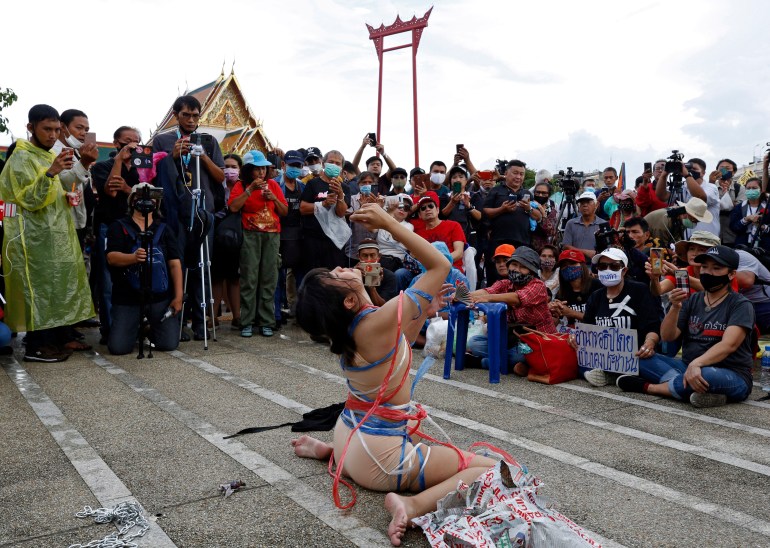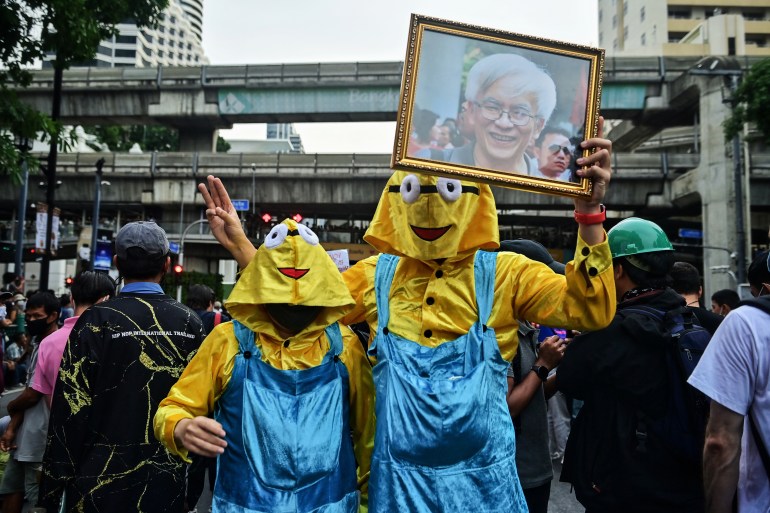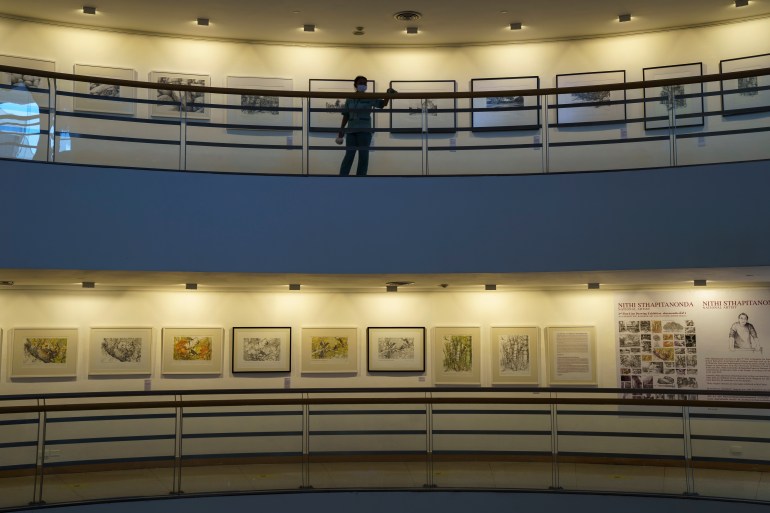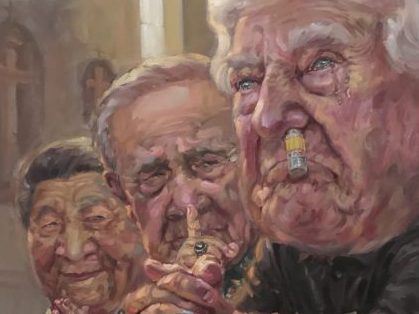Politics and pestilence occupy minds at Bangkok Art Biennale | Thailand
Bangkok, Thailand – The painting on the wall shows three immensely wrinkled men – US President Donald Trump, Thailand’s Prime Minister Prayuth Chan-ocha, and Chinese President Xi Jinping – leaning on what appears to be a pew.
Wedged into Trump’s left nostril is a capsule of Poy-Sian, a product that Thais sniff to relieve headaches.
The artist, Lampu Kansanoh, who is exhibiting at the Bangkok Art Biennale says the painting is about the stress Trump faces in his dealings with China.
“Here [in Thailand] when people get sick or have pain we always use Poy-Sian,” she told Al Jazeera. “Now Trump is the one who has to deal with a lot of problems. So, he has to use it. Now until next 50 years, if when they get old they are still leaders, I think the problems will still be the same.”
This year’s biennale, which opened on October 31, is taking place not only against the backdrop of a bitter presidential election in the United States, but also a global pandemic that has killed more than a million people, prompted unprecedented lockdowns and destroyed economies. In Thailand itself, there have also been mass protests, with the country’s young people calling for Prayuth to resign and reforms to the country’s long-untouchable monarchy.
“Generations of humans have tried to find their escape routes,” said Apinan Poshyananda, the event’s chief executive and a renowned art curator. “Today, it seems that humanity is still entrapped. With man-made chaos, climate change, clashes in ideologies, faith and religion.”
The chaos, however, is also encouraging more young people to get creative whether because of uncertainty about their future careers or a need to express themselves.
“The politics of the new art, I think, is partly the result of unrest, some of it arising from severe economic downturn and harsh lockdowns to do with the pandemic,” Gwen Robinson, a veteran journalist and senior fellow at Bangkok’s Chulalongkorn University, told a panel at the opening of the biennale, noting that a lot of young people also had parents who had lost their jobs or been forced to take large pay cuts.
 Protesters watch a performance artist during a rally for political reforms in August [Narong Sangnak/EPA]
Protesters watch a performance artist during a rally for political reforms in August [Narong Sangnak/EPA] Pro-democracy protesters dressed up as the ‘minions’ from the film Despicable Me with a portrait of Somsak Jeamteerasakul, a exiled Thai academic during a rally last month [Lillian Suwanrumpha/AFP]
Pro-democracy protesters dressed up as the ‘minions’ from the film Despicable Me with a portrait of Somsak Jeamteerasakul, a exiled Thai academic during a rally last month [Lillian Suwanrumpha/AFP]Robinson says the frustration is increasing a new form of protest art, “emerging in the form of clothing, language, and protest tactics.”
Art and protest
The protesters, who have been taking to the streets since July, have expressed their rambunctiousness in costume, many of which are satirical and employ seemingly absurd accessories like inflatable pool ducks.
Last month, demonstrators – including high school students – dressed as the yellow minion characters from the cartoon Despicable Me in a parody of the Yellow Shirts movement which supports the Thai monarchy.
Some have also worn crop tops to mimic the king who has been photographed in similar outfits in Germany where he has spent much of this time since taking the throne.
Their movement has attracted the support of the artists exhibiting at the biennale with 25 of them signing an open letter last month in support of the “struggle for democracy”.
Panu Boonpipattanapong, an art critic, says protesters are sometimes more savvier than conventional artists in their ability to harness art for social change.
“The protesters who work for democracy, I think in some sense, they’re more updated, they’re more witty, or they’re quicker than us,” he said. “I don’t blame art people. I don’t blame the biennale, but when we compare normal people who use art as instrumental or a weapon to communicate, to understand people, I think they are far beyond us in our scene.”
 The biennale is taking place at various venues in the capital and the Bangkok Art and Culture Center (BACC), which has been left almost deserted as a result of the COVID-19 pandemic [File: Athit Perawongmetha/Reuters]
The biennale is taking place at various venues in the capital and the Bangkok Art and Culture Center (BACC), which has been left almost deserted as a result of the COVID-19 pandemic [File: Athit Perawongmetha/Reuters]The biennale features works by artists from 37 different countries including the world-renowned Ai Weiwei and Anish Kapoor, and will run until January 2021. Poshyananda says the symposium, one of the few art events to take place this year as a result of the COVID-19 pandemic, “focuses on the three problems we are facing: famine, plague, and war.”
Much of the work is socio-political and interrogates humanity’s desperation to escape its problems. There is a sculpture of a ship filled with refugees and a film about the role of religion in providing a spiritual escape from danger in southern parts of Thailand, which are mostly Muslim and where an armed conflict has been rumbling since 2004.
Longing for peace
I-na Phuyuthanon, who made the film, which shows a woman covered from head to toe walking through the forest interspersed with verses from the Quran, says it depicts her longing for the peace that religion has brought her in a region plagued with violence.
Villagers in the area where it was filmed have had a difficult relationship with the armed forces, I-na explains, adding that the soldiers, who she says do not understand Islam, insult and tease the villagers as they pass between checkpoints.
“I want to present the trust of Allah in Islam,” she said. “My past video art presented a painful loss, whether it is my fear, death, victimisation and violence, but in this I wanted to present the beauty from the area.”
Push/Pull, 2020 by Anish Kapoor at Wat Pho.
For more information about Anish Kapoor and his artworks visit https://t.co/2m8KzgfOrw
#BAB2020#BangkokArtBiennale#EscapeRoutes#ศิลป์สร้างทางสุข pic.twitter.com/703OeeHjOB— Bangkok Art Biennale (@bkkartbiennale) October 30, 2020
Artists from the New York and Bangkok-based New-Territories MindMachineMakingMyths also interpreted escape in a more personal way.
For the work, American actress Caitlin Lee Haas-Chullasapya performed in front of a sculpture, re-enacting her experiences under the influence of psychedelic medicinal mushrooms, which she said had helped her through recent memory loss.
For Thai artists such as Lampu the longing to escape goes beyond the challenges people in many countries around the world have faced this year – it is about peoples’ need for change and an instinct that things can be different.
“In my opinion, whether you are in a developed or underdeveloped country every place has its own problems,” Lampu said. “People want things that they never had.”

